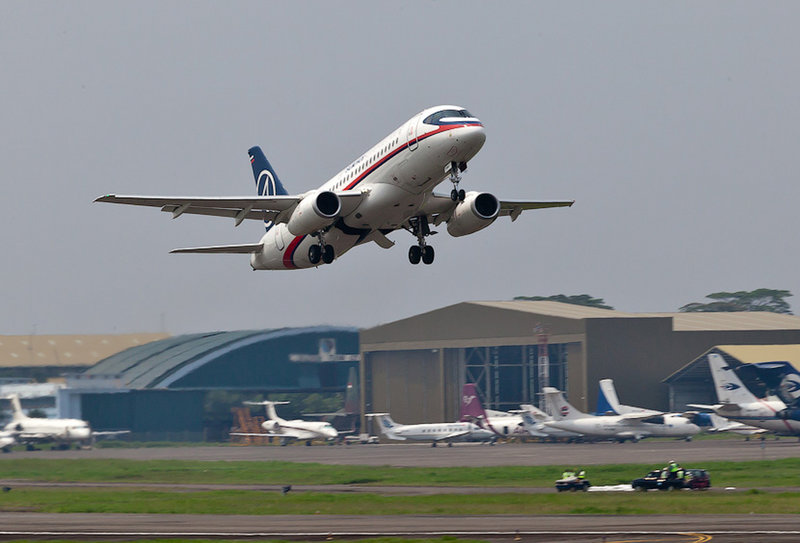JAKARTA, Indonesia – The crash of a Russian-made passenger jet into the side of an Indonesian volcano has put a spotlight on the notoriously informal atmosphere aboard new aircraft during manufacturer demonstrations — known here as “joy flights.”
These junkets for potential buyers commonly see passengers join or cancel at the last minute, wreaking havoc on manifest lists. Pilots eager to show off the versatility of their planes often make lightning-fast ascents and buzz famous landmarks.
With no sign yet of the black boxes, it is not clear what caused the Sukhoi Superjet 100 to smash into the side of Mount Salak on Wednesday, presumably killing all 45 people on board. An investigation by a joint team of Indonesian and Russian experts is expected to take at least a year.
There is nothing to suggest the pilot did anything wrong. But the disaster is a reminder of the continuing concerns of air-safety specialists about demonstration flights. That’s true not just in Indonesia but globally.
Tom Ballantyne, a Sydney-based aviation expert, has gone on many such trips.
“The purpose of these flights obviously is to show off the aircraft to potential customers,” he said. “If they are flying over a landmark, they might circle around it so the passengers can get a better look. They might fly a little lower or show the rate of climb of the aircraft.”
That’s not to say they don’t follow the rules, he said, or push the planes beyond what they are capable.
“But there’s definitely a bit of showing off,” he said.
With 240 million people and a rapidly growing middle class hungry for cheap air travel, manufacturers will continue to flock to Indonesia, as evidenced by a purchase late last year by the little-known airline Lion Air.
Its order of 230 planes from Boeing Co. was the manufacturer’s biggest ever, and the carrier said it will need smaller aircraft as well. Many other Indonesian carriers also are trying to build up or modernize their fleets.
The ill-fated Superjet was carrying dozens of representatives from local airlines and journalists on what was supposed to be a 50-minute flight to Java island and back. Pictures posted on social networking sites such as Facebook showed excited passengers, smiling and waving in front of the twin-engine jet before takeoff. Others sipped champagne handed out in the cabin by glamorous air hostess wearing electric-blue pencil skirts.
Soon after takeoff from a Jakarta airfield, however, the Russian pilot and co-pilot asked air traffic control for permission to drop from 10,000 feet to 6,000 feet.
The plane disappeared from the radar immediately afterward — with new satellite imagery revealing heavy cloud cover and rain. It’s not clear if that’s why the crew asked to drop or if they got a response. Officials here say they didn’t.
The pilots on demonstration flights are known to be experienced, often having spent years flying for major airlines.
Alexander Yablontsev, in charge of Wednesday’s flight, was no exception, logging 10,000 hours in the Sukhoi Superjet and its prototypes.
“He was our best testing pilot,” said Mikhail Pogosian, head of United Aircraft Corporation, which built the SuperJet. He said Yablontsev oversaw “everything from the designing of the aircraft to its certification.”
Even so, at least one decision has come into question — the flight path.
“As I understand it, it was the pilot who asked to pass Mount Salak,” said Ruth Simatunpang, a former investigator with the National Commission on Safety Transportation.
The long-dormant volcano has been the scene of seven crashes in the last decade, Wednesday’s by far the deadliest, trailed by a 2008 Indonesian air force accident that killed 18.
Its jagged peaks are often shrouded in heavy mist.
“Usually, in a demo flight, you would go out of your way to avoid a route that is full of obstacles,” Simatunpang said.
“But almost everyone knows Salak is dangerous and that the weather is extremely unpredictable,” she said.
Send questions/comments to the editors.



Success. Please wait for the page to reload. If the page does not reload within 5 seconds, please refresh the page.
Enter your email and password to access comments.
Hi, to comment on stories you must . This profile is in addition to your subscription and website login.
Already have a commenting profile? .
Invalid username/password.
Please check your email to confirm and complete your registration.
Only subscribers are eligible to post comments. Please subscribe or login first for digital access. Here’s why.
Use the form below to reset your password. When you've submitted your account email, we will send an email with a reset code.